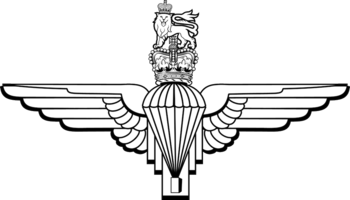Note: This is part three of a multi-part series exploring elite components within the conventional British forces.
During WWII, the British military required an elite airborne unit trained to fight behind enemy lines, and so the Parachute Regiment was born. The elite airborne unit, also known as the Paras, jumped into occupied Germany. Their mission was to capture crucial enemy positions and remain until the rest of the invasion force arrived.
The present day Parachute Regiment provides elite infantrymen to Britain’s rapid response airborne formation, the 16 Air Assault Brigade. The regiment also provides infantry support to United Kingdom Special Forces (UKSF). The Parachute Regiment consist of 1 Para (SFSG); 2 Para; 3 Para; and a reserve unit, 4 Para.

The regiment’s demanding training and culture instill a powerful sense of confidence and aggression in these airborne warriors. The Paras’ regimental motto is “Utrinque Paratus” (Ready for Anything). Their ethos and discipline make Paras optimal candidates for joining the Special Air Service.
Operational History
The Parachute Regiment was involved in many operations during World War II. Their last combat jump dates back to November 5, 1956, when the unit took part in Operation Musketeer. Members of 3 Para jumped into Egypt and secured the El Gamil airfield during the Suez crisis. The Parachute Regiment would further distinguish itself during the 1982 Falkland campaign, where they won several key battles to secure Britain’s victory over Argentina.
The Parachute Regiment should be locked up and only be let out in time of war.” – Margaret Thatcher (The Iron Lady)
Members of 3 Para deployed to Helmand Province, Afghanistan in 2006, where they fought bloody battles with Taliban forces daily. Paras in the form of the Special Forces Support Group (SFSG) continue to support the UKSF. Members of the Parachute Regiment have been awarded five of the last six Victoria Crosses (VCs). Among them was James Ashworth, who served with 3 Para and was posthumously awarded the Victoria Cross in June, 2012.
Notable Parachute Regiment Operations
- 1982 – Operation Corporate
The Parachute Regiment in the Falklands Conflict - 1999 – Operation Agricola
The Paras in Kosovo - 2000 – Operation Palliser
1 Para Battle Group in Sierra Leone - 2001 – Operation Essential Harvest
2 Para, as part of 16 AA Bde, took part in the NATO operation to gather and destroy the weapons of ethnic Albanian groups in Macedonia. - 2002 – Operation Veritas
As part of NATO efforts to stabilize Afghanistan, 2 Para deployed to the capital, Kabul. - 2003 – Operation Telic
1 and 3 Para, reinforced by 100+ troops from 4 Para, deployed with the 16 Air Assault Brigade for the British contribution to the U.S.-led invasion of Iraq. - 2006 – Operation Herrick IV
3 Para, at the core of 3 Para Battle Group, deployed to Helmand Province, Afghanistan as part of ongoing NATO stabilization and reconstruction efforts in the region.
Pegasus Company (P COY)
Potential Parachute Regiment soldiers and all soldiers wishing to join the 16 Air Assault Brigade must go through pre-parachute selection (PPS), run by Pegasus Company (P Coy) at the Infantry Training Center in Catterick, North Yorkshire.
Test Week
All PPS courses feature a series of eight tests held over seven days. Regular Para recruits undergo PPS during week 20 of their training. These tests include:
- 10 miler while carrying 35 lb. bergen (rucksack) and a rifle, to be completed in 1 hour 50 minutes or less.
- Trainasium: an assault course designed to test a candidate’s tolerance for heights.
- Log Race: Eight-man team carrying a 60kg log over a distance of 1.9 kilometers
- Two-mile march carrying a 35 lb. bergen, food, water, and a rifle, to be completed in 18 minutes or less
- Steeplechase: 1.8 mile cross-country course featuring water obstacles and an assault course
- Milling (training exercise): Tests if the recruit has the aggression and determination required of a paratrooper. Recruits must aggressively pummel their opponent while wearing boxing gloves and headgear.
- Endurance march: 20-mile march made while carrying 35 lb. bergen, water, food, and a rifle, to be completed in four hours or less. (Territorial Army recruits do not undertake the endurance march.)
- Stretcher Race: 16-man teams carry a 175 lb. stretcher over five miles

What Manner of Men Are These That Wear the Maroon Beret?
They are firstly all volunteers and are toughened by physical training. As a result they have infectious optimism and that offensive eagerness which comes from well-being. They have ‘jumped’ from the air and by doing so have conquered fear.
Their duty lies in the van of the battle. They are proud of this honour. They have the highest standards in all things whether it be skill in battle or smartness in the execution of all peace time duties. They are in fact – men apart – every man an emperor.
Of all the factors, which make for success in battle, the spirit of the warrior is the most decisive. That spirit will be found in full measure in the men who wear the maroon beret”
― Bernard Montgomery










COMMENTS
You must become a subscriber or login to view or post comments on this article.